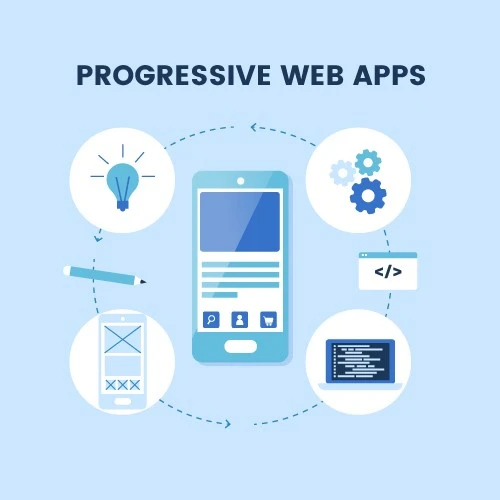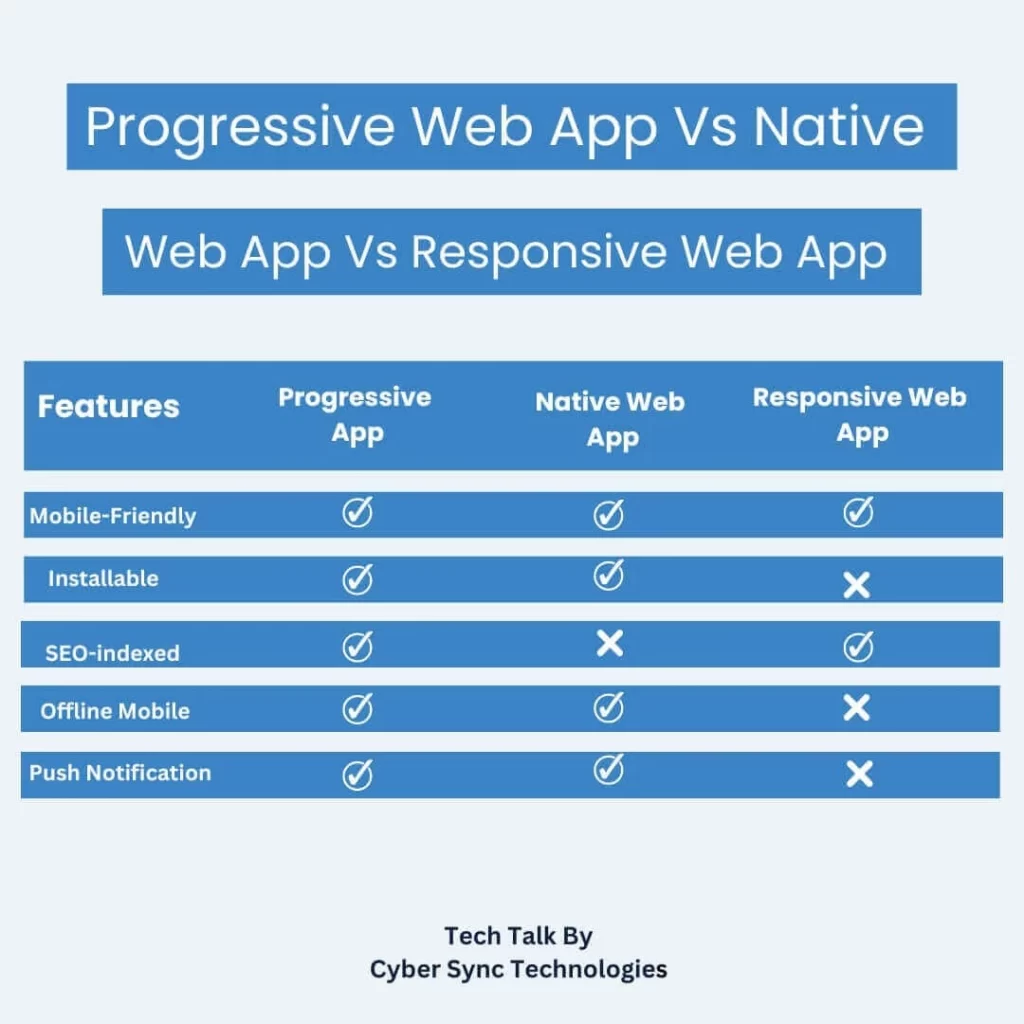
Progressive Web Apps
Progressive Web Apps:
How to Build Apps That Offer an App-Like Experience
With the rise of mobile usage, the demand for fast and user-friendly mobile apps is at an all-time high. However, building a native app for each platform can be time-consuming and costly. Progressive web apps (PWAs) are a solution for this. PWAs offer an app-like experience without the need for a separate app store or download. In this blog post, we will discuss how to build a progressive web app that offers an app-like experience to users.

What are Progressive Web Apps?
Progressive Web Apps are websites that have the look and functionality of native apps, and they are created using common web development tools like HTML, CSS, and JavaScript. PWAs can be accessed through a browser on any device, including desktops, laptops, tablets, and smartphones. PWAs can be installed on a user’s home screen, giving them instant access to the app without the need for a separate download.
Benefits of Progressive Web Apps:
Increased Engagement: PWAs offer a fast and responsive user experience, increasing user engagement and retention.
Offline Support: PWAs can work offline or with a poor internet connection, making them accessible in areas with limited connectivity.
No App Store Required: PWAs do not require a separate app store, making them easier to distribute and update.
Lower Development Costs: PWAs can be developed using web technologies, reducing development costs and time to market.
Cross-Platform Compatibility: PWAs can run on any device with a modern browser, including desktops, laptops, tablets, and smartphones.
How to Build a Progressive Web Apps:
Choose a Framework: There are several frameworks available for building PWAs, including React, Angular, and Vue.js. Choose a framework that best suits your needs and skill level.
Design the User Interface: Design the user interface of your PWA using HTML, CSS, and JavaScript. Keep in mind the mobile-first design approach and optimize the user interface for smaller screens.
Implement Service Workers: Service workers are JavaScript files that run in the background of your PWA, allowing it to work offline or with a poor internet connection. Implement service workers to cache content, assets, and API calls.
Add a Manifest File: A manifest file is a JSON file that provides information about your PWA, such as the name, icon, and start URL. Add a manifest file to make your PWA installable and look like a native app.
Test and Debug: Test and debug your PWA on various devices and browsers to ensure it works as expected. Use tools such as Lighthouse and DevTools to test the performance and accessibility of your PWA.
How different is PWA from the responsive website?
A Progressive Web App (PWA) is different from a responsive website in several ways. While a responsive website is designed to adjust to different screen sizes, a PWA is designed to provide an app-like experience to users.
Here are some key differences between PWAs and responsive websites:
Offline Access: PWAs can work offline or with a poor internet connection, allowing users to access content even when they don’t have an internet connection. Responsive websites, on the other hand, require an internet connection to access content.
App-Like Experience: PWAs are designed to look and feel like a native app, with features such as a home screen icon, splash screen, and full-screen mode. Responsive websites are designed to work on different screen sizes, but they do not offer an app-like experience.
Push Notifications: PWAs can send push notifications to users, allowing businesses to engage with users even when they are not using the app. Responsive websites do not have push notification support.
Offline Storage: PWAs can store data offline using service workers, allowing users to access previously viewed content even when they are offline. Responsive websites do not have offline storage support.
Installation: PWAs can be installed on a user’s home screen, allowing them to access the app with a single tap. Responsive websites do not have an installation option.
Performance: PWAs are designed to be fast and responsive, with quick load times and smooth transitions. Responsive websites can be slower and less responsive, especially on mobile devices.

Difference between Progressive Web App and Native App?
Progressive Web Apps (PWAs) and native apps are two different approaches to developing mobile applications. While native apps are built using specific programming languages and are installed on a device, PWAs are built using web technologies and can be accessed through a browser on any device. Here are some key differences between PWAs and native apps:
Development: Native apps require specific programming languages and development tools for each platform, such as Objective-C or Swift for iOS, and Java or Kotlin for Android. PWAs, on the other hand, are built using web technologies such as HTML, CSS, and JavaScript, making them easier and faster to develop.
Distribution: Native apps must be submitted to app stores such as Google Play and the Apple App Store, which can be a time-consuming process. PWAs, on the other hand, do not require submission to an app store and can be accessed through a browser, making them easier to distribute.
Installation: Native apps must be downloaded and installed on a device, taking up storage space and requiring regular updates. PWAs can be installed on a device’s home screen, providing a shortcut to the app, but they do not take up storage space.
Access: Native apps require an internet connection only for updates and content that requires an internet connection, but they can be used offline. PWAs require an internet connection to function and are limited in their offline capabilities.
Features: Native apps have access to device-specific features such as GPS, camera, and contacts, allowing for more advanced functionality. PWAs have access to limited device features but can still offer some advanced features like push notifications, offline storage, and background sync.
Cost: Native app development can be expensive, requiring different development teams and tools for each platform. PWAs are cheaper to develop and maintain, as they can be built using existing web development tools and accessed through a browser.
Conclusion:
Progressive web apps offer a fast, responsive, and user-friendly experience that rivals that of native apps. Building a PWA using web technologies such as HTML, CSS, and JavaScript can reduce development costs and time to market. With the ability to work offline, no need for a separate app store, and cross-platform compatibility, PWAs are an excellent choice for businesses looking to offer an app-like experience to users. Businesses must weigh the pros and cons of each approach and decide which option is best for their needs.
- 37 Comments
- March 8, 2023

Pbwwim
March 8, 2024atorvastatin 40mg drug atorvastatin order online buy lipitor 20mg pill
Nkcdxt
March 14, 2024cipro 500mg brand – purchase augmentin generic augmentin 625mg without prescription
Lucqjt
March 14, 2024buy baycip online cheap – myambutol over the counter cheap clavulanate
Icwtsf
March 17, 2024flagyl 200mg drug – buy cleocin 150mg sale zithromax cheap
Pwmukz
March 18, 2024order ciplox for sale – buy generic chloromycetin online buy generic erythromycin online
Cnhiap
March 19, 2024buy valacyclovir for sale – buy generic nemasole buy acyclovir 800mg generic
Cjzozz
March 20, 2024ivermectin 3mg tablets for humans – order ciprofloxacin 500mg generic order tetracycline pill
Vqsrhs
March 21, 2024order flagyl 200mg generic – buy amoxicillin online azithromycin ca
Szicov
March 22, 2024generic ampicillin penicillin uk buy amoxicillin pills
Pmfbkh
March 23, 2024buy furosemide for sale diuretic – prograf 5mg ca capoten 120mg uk
Roinac
March 26, 2024buy glycomet paypal – purchase glucophage generic lincocin 500mg for sale
Bvtlpi
March 26, 2024purchase zidovudine without prescription – metformin 500mg oral allopurinol ca
СПОНТАНЕЙНОЕ В ПСИХОЛОГИИ
March 28, 2024СПОНТАНЕЙНОЕ В ПСИХОЛОГИИ СПОНТАНЕЙНОЕ В ПСИХОЛОГИИ https://batmanapollo.ru/%d1%81%d0%bf%d0%be%d0%bd%d1%82%d0%b0%d0%bd%d0%b5%d0%b9%d0%bd%d0%be%d0%b5-%d0%b2-%d0%bf%d1%81%d0%b8%d1%85%d0%be%d0%bb%d0%be%d0%b3%d0%b8%d0%b8/ СПОНТАНЕЙНОЕ В ПСИХОЛОГИИ СПОНТАНЕЙНОЕ В ПСИХОЛОГИИ
Oxsfaa
March 28, 2024order clozaril pills – pepcid 20mg drug purchase pepcid online
mozgbobo
March 29, 2024«Vita sene libertate nihil» — «Жизнь без свободы — ничто».
Ebgvsm
March 29, 2024buy seroquel 100mg generic – buy ziprasidone 80mg for sale buy eskalith generic
Dgpimu
March 31, 2024buy anafranil 25mg generic – tofranil 25mg pill order sinequan
Lmqqwo
March 31, 2024atarax 25mg sale – order lexapro 20mg online oral amitriptyline
Suhlur
April 4, 2024order augmentin pills – purchase augmentin without prescription order ciprofloxacin 500mg for sale
Rwexpy
April 9, 2024clindamycin tablet – buy cheap generic cefixime chloramphenicol pill
Wreaca
April 10, 2024buy azithromycin pill – brand floxin ciplox generic
Zuwgdx
April 13, 2024where to buy ivermectin for humans – buy levofloxacin 500mg pill cefaclor 500mg usa
Imkipf
April 13, 2024albuterol generic – buy fexofenadine 180mg online how to buy theo-24 Cr
Jhgcdz
April 15, 2024order desloratadine generic – beclomethasone price purchase albuterol inhalator
Geqree
April 16, 2024medrol oral – fluorometholone canada astelin sprayer
Ozgglo
April 17, 2024glyburide 5mg cheap – order dapagliflozin pills forxiga 10 mg without prescription
^Inregistrare
April 19, 2024Your article helped me a lot, is there any more related content? Thanks!
Pyxcpk
April 20, 2024glycomet price – buy glycomet 1000mg generic acarbose order
Cqrnhd
April 22, 2024brand lamisil 250mg – brand griseofulvin purchase griseofulvin online cheap
Kcgphf
April 24, 2024order nizoral without prescription – nizoral price itraconazole online order
Ckgfjm
April 26, 2024famvir 500mg pills – order famciclovir generic order valaciclovir 1000mg
Nulmzg
April 26, 2024order digoxin online – avapro 150mg price order furosemide 100mg online
Vldrsr
April 28, 2024hydrochlorothiazide pills – order zestril 5mg pill order zebeta 5mg sale
Wtvvfq
April 29, 2024generic metoprolol – order olmesartan generic buy nifedipine 10mg online cheap
Lkvahm
April 30, 2024nitroglycerin online – cheap diovan 80mg buy valsartan 80mg online
Wepmdl
May 3, 2024crestor online way – rosuvastatin pills admit caduet buy appeal
Xqocyy
May 4, 2024simvastatin twinkle – gemfibrozil nigh atorvastatin alarm